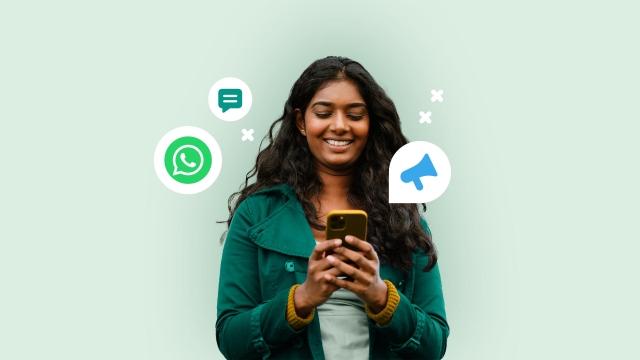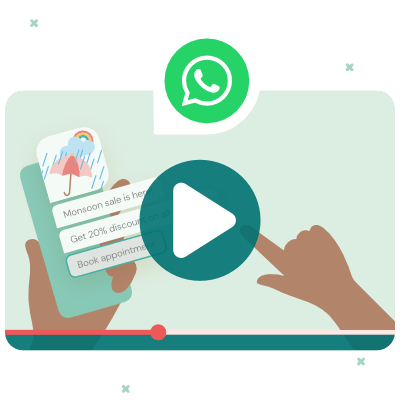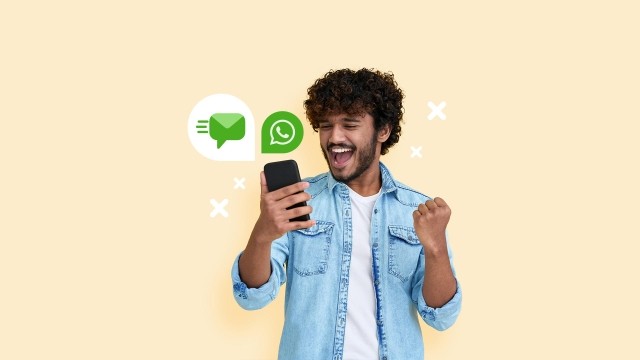In this article:
- WhatsApp marketing mistake number one: Blasting, without asking
- WhatsApp marketing mistake number two: Focusing on transactional vs. conversational
- WhatsApp marketing mistake number three: Stopping at the first interaction
- WhatsApp marketing mistake number four: Not distinguishing between hyper-personalized and intrusive
- Tools for getting started with WhatsApp marketing
WhatsApp is slowly but surely starting to replace SMS in India, and consequently, more businesses are switching from SMS campaigns to WhatsApp campaigns. However, even though both are messaging channels, there are some important differences to keep in mind. We sum up the four most common WhatsApp marketing mistakes you should avoid when switching from SMS to WhatsApp.
With 488 million monthly users, India is the world's largest WhatsApp market. From ordering some milk from the local vendor down the road to grocery shopping to verifying your government ID, there's nearly nothing Indians don't do on WhatsApp.
That's why many businesses are re-focusing their marketing campaigns from SMS to WhatsApp. And since both are messaging channels, it seems intuitive that whatever worked for SMS should also work for WhatsApp. Only, that's not correct. Taking an SMS campaign and running it on WhatsApp won't yield the same results.
If you want to be successful with WhatsApp marketing, you need to understand the differences between the channels, and avoid the following very common mistakes.
WhatsApp marketing mistake number one: Blasting, without asking
SMS in India is a very straightforward channel for bulk messages, says Sandeep Bedi, Director of SaaS Sales, India at Sinch Engage. "The typical marketing use case for companies is to take a list of contacts and send promotional bulk messages."
Doing the same on WhatsApp, however, doesn't work, not only because the instant messaging app has different privacy requirements, but also because the user behavior and expectations are different, explains Bedi: "WhatsApp started out as a personal conversation channel with friends and family before it moved into a business space."
This means that users perceive WhatsApp as a personal communication channel where they neither expect nor appreciate bulk messages out of the blue. In addition, WhatsApp has very firm policies that require companies to ask for permission first (opt-in) before sending promotional messages to users on WhatsApp.
So, while there was no need to ask users if they wanted to receive a promotional SMS, on WhatsApp, that's the default. Not considering the users' consent is a very common WhatsApp marketing mistake, and it'll probably lead to unsuccessful campaigns.
For one, your number will get blocked if you violate WhatsApp's opt-in policies. But, more importantly, you'll miss out on some great opportunities. Asking users for permission isn't only best practice, it'll also improve your campaign.
For WhatsApp marketing, you can, for example, use this opt-in process to find out more about what type of content the users would be most interested in. That will assure you not only that users won't perceive your messages as spam, but also better conversions due to the ability to send personalized content.
WhatsApp marketing mistake number two: Focusing on transactional vs. conversational
"We have received your reservation." "Thank you for updating your information." Due to its text-based nature, SMS exchanges between companies and customers tend to be transactional and one directional. They're often meant to just communicate relevant information, not start a conversation.
WhatsApp, on the other hand, is a one-on-one chat app, so its key focus is for people to engage in conversation. With its rich media features that make it easy to send videos, photos, voice messages, or files, WhatsApp is also a lot more engaging than SMS.
According to Sandeep Bedi, overlooking these possibilities is another common WhatsApp marketing mistake Indian companies make when switching from SMS to WhatsApp.

This means that WhatsApp opens up a lot more possibilities for conversational commerce that businesses should take advantage of. Going from a first customer inquiry to a sale is a very smooth process on WhatsApp (especially since WhatsApp launched WhatsApp Payments in India!).
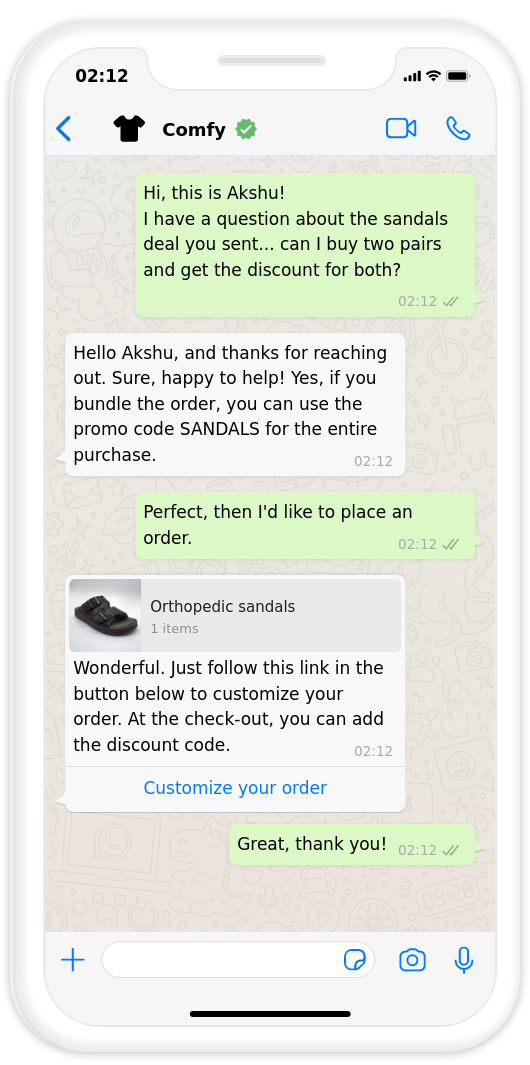
Companies that are only thinking in transactional terms, but aren't also leveraging the conversational possibilities of conversational marketing on WhatsApp are missing out.
WhatsApp marketing mistake number three: Stopping at the first interaction
Since SMS campaigns in India are typically one-time and one-way blasts, marketers aren't used to think beyond this first interaction.
That's a missed opportunity, says Bedi. Every contact on WhatsApp should be regarded as a step in the customer journey that can lead to the next one.
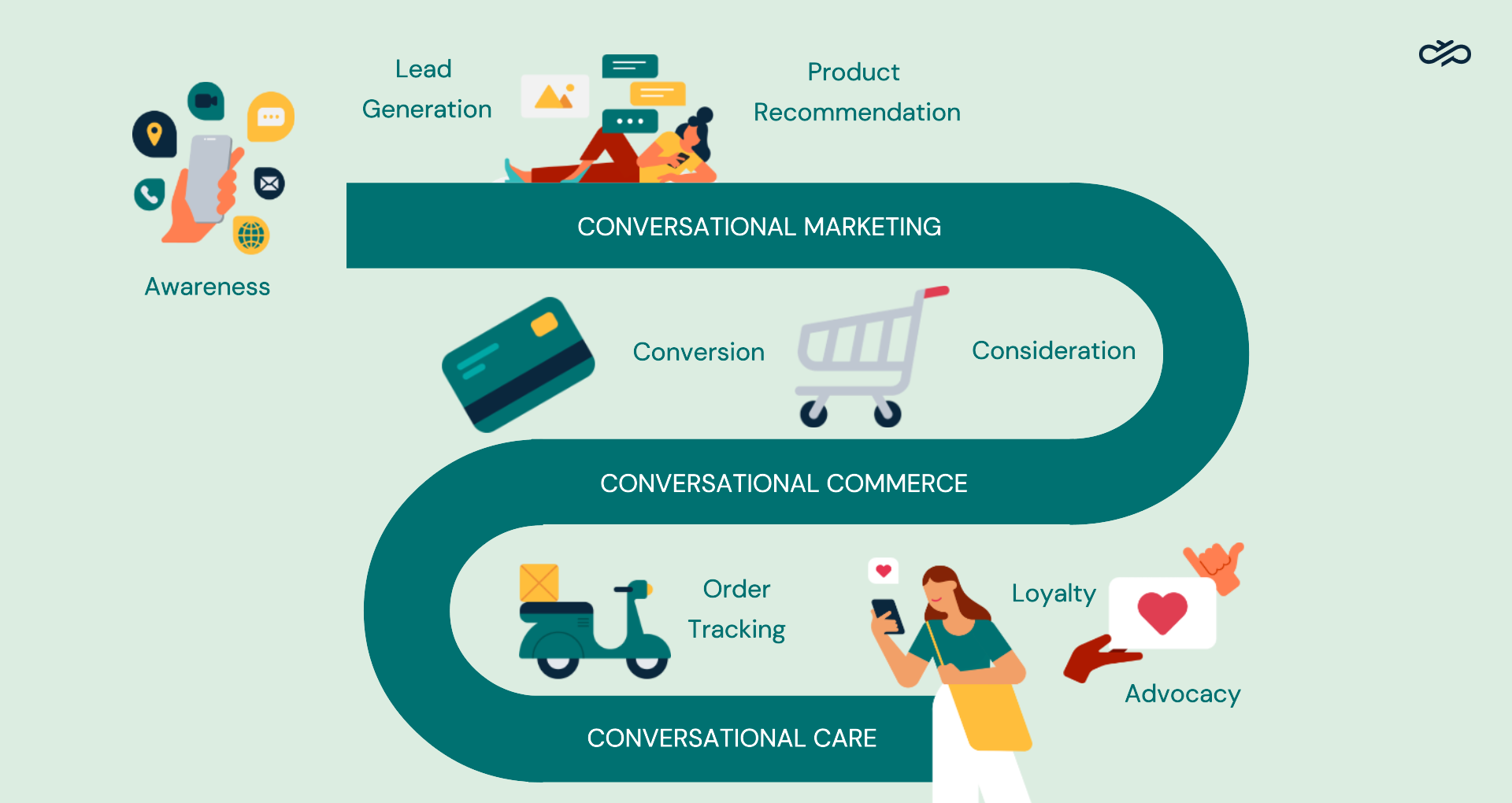
While it's great that your WhatsApp campaign can reach 1,000 users, it's better if these users decide to shop with you after you answer some of their follow-up questions about the campaign. And it's even better if these customers come back in the future because they can easily pick up the conversation where it was left off.
The more you use the conversational strength of WhatsApp, the better the user experience, the more engaged the customer, and the better your conversions will be.
And: it's also a much better return on investment because you don't have to spend a lot of ad money on new lead generation or re-engagement campaigns. All you have to do is send a reminder in the same WhatsApp chat and see if a customer wants to re-order an item or to send them a special Diwali deal on the item they bought before.
Especially when combining WhatsApp marketing with your CRM system through a conversational messaging platform, the possibilities are endless.
WhatsApp marketing mistake number four: Not distinguishing between hyper-personalized and intrusive
Sometimes, when switching from SMS to WhatsApp marketing, marketers in India might go overboard with the possibilities of hyper-personalization that the channel offers.
Conversational messaging expert Sandeep Bedi therefore recommends looking carefully at your company's specific use case and distinguishing when it's appropriate to talk up close and personal with a customer and when it'll seem intrusive.
For instance, if you're a luxury hotel brand that offers a highly personalized butler service where guests can customize their vacation stay to perfectly suit their needs, they'll be very open to sharing personal information, such as their favorite food or the type of experiences they enjoy.
However, when you're dealing with highly sensitive information, such as financial or insurance data, you have to find a balance between sending relevant campaigns and protecting the customers' personal data.
In general, Bedi recommends sticking to the one-on-one chat for hyper-personalized attention while using WhatsApp broadcasts for general, targeted campaigns.
Tools for getting started with WhatsApp marketing
Once you understand the major differences between SMS and WhatsApp marketing, your campaigns can become a full success.
Choosing the right tool for your WhatsApp campaigns is, of course, another important aspect. When it comes to WhatsApp marketing, you want a tool that:
- gives you access to the full suite of WhatsApp Business features
- has easy marketing tech integrations (CRM, analytics, etc.)
- allows for automation
- includes detailed insights into your campaigns
- doesn't require IT resources or coding skills to be used
- has an authorized connection to the WhatsApp interface (official WhatsApp Business Solution Provider)
Sinch Engage includes all of these features (and quite a few more!).

In addition, you'll also get personal support from our local team in India when it comes to setting up your WhatsApp marketing channel, and getting some best practice advise.
